We hope that each of you, our readers, will enjoy and appreciate this article we present about these 7 Gorgeous Invertebrates of Georgia. It was certainly our pleasure to gather the information for you. May it provide you with both education and increased awareness.
Certainly, these few species listed herein represent only a portion of the wonders found in this amazing region. It’s our belief, though, that they serve as excellent representations of the wonders found here. Check out some of our other articles for similar marvels.
Eastern Tiger Swallowtail
Eastern Tiger Swallowtail Facts
- Leading off this article about 7 Gorgeous Invertebrates of Georgia we present to you the mesmeric beauty of the Eastern Tiger Swallowtail.
- This breathtaking Lepidoptera most commonly goes by the somewhat informative common name across its entire native range. Surprisingly, this Arthropod has no other widely accepted general name. That sets it apart from many related species.
- Within certain circles, however, it’s better known by another moniker. That’s its official, technical name. In the annals of science, it holds the name of the Papilio glaucus. Fortunately for the layperson, that’s a much simpler term than most hold.
- The stunning insect received that name due to the efforts of the esteemed Swedish zoologist, Carl Linnaeus. He accomplished the first recorded recognition of it as a separate and distinct species. That scientifically noteworthy action occurred in 1758.
- Its great visual appeal further led to it holding a unique distinction. Within the region it inhabits, it’s been named the official state butterfly of five different states. More specifically still, this marvel’s also the formal state insect of yet another state.
- Thankfully, the gorgeous Eastern Tiger Swallowtail seems to be maintaining a population base that’s both sufficient and stable. That also appears to hold true throughout the entirety of its range. The IUCN, thus has no listing for it on its Red List.
- The remarkable creature nevertheless faces the same threats as most species, at least. Many of these occur directly due to the actions of man. Habitat degradation and loss pose a possible danger. It also faces the potential threat of ongoing climate change.
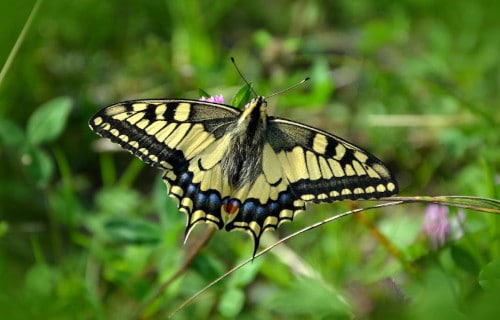
Eastern Tiger Swallowtail Physical Description
The magnificent Eastern Tiger Swallowtail immediately captivates those who encounter it. Unlike some of its relatives, though, it does so for several reasons. Is beauty alone would suffice to impress, to be certain. Yet this wonder of Nature also ranks as a large butterfly.
It does follow one pattern common among Lepidoptera, however. That’s because, like them, it displays a moderate degree of the physiological trait of sexual dimorphism. In its specific case, though, this natural characteristic manifests in both size and appearance.
Females of the beautiful species typically attain a slightly greater wingspan. Interestingly, this also varies according to region. This measurement thus depends greatly on the area in which the individual lives. Overall, however, this averages from 3.1 – 5.5 in (7.9 – 14 cm).
Individuals from the more northern part of its range tend to be smaller than their southern counterparts. This has no apparent impact on their coloring, though. The two sexes, do, however, disintinguish themselves here, too. And the females complicate things further.
Males of the Eastern Tiger Swallowtail present predominantly bright yellow wings. Four black stripes also appear on each forewing. The outer edge also shows black, with a series of yellow dots. The hindwing shows a mixture of yellow, red, and blue spots in various places.
Yet the females show two separate distinct patterns. Some present a primarily dark gray or black background across both wings. Others displays a mainly yellow background, like the males. Faint blue areas also appear on the hindwings, and a row of orange spots.
- Kingdom: Animalia
- Phylum: Arthropoda
- Class: Insecta
- Order: Lepidoptera
- Family: Papilionidae
- Genus: Papilio
- Species: P. glaucus
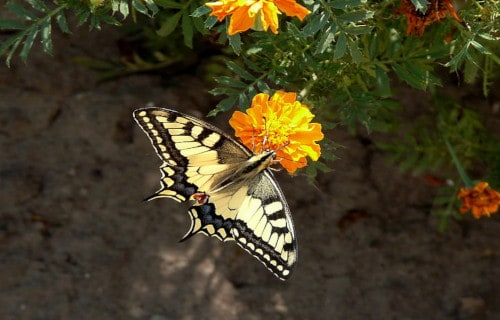
Eastern Tiger Swallowtail Distribution, Habitat, and Ecology
The visual splendor that is the Eastern Tiger Swallowtail evolved as native to a limited region of the world. That area, however, is one that likely won’t surprise many people. That’s true since this marvel of Nature evolved as native to a specific portion of North America.
Even there, though, its range remains limited. It only lives within the boundaries of the United States. As its name indicates, it further lives only in the eastern part of the country. That range extends south from Vermont to Florida, and then west to Texas and the plains.
This lovely Arthropod evolved as comparatively adaptible in terms of habitat requirements. Within its range, it makes its home anywhere deciduous forests appear. This includes such locations as fields, woodlands, creeks, rivers, roadsides, and gardens.
Yet this fabulous creation of evolution doesn’t stop there in its habitation practices. That’s because it does not hesitate to venture into regions of densely concentrated human populations. Due to this, it’s a common sight in city parks, private yards and gardens, as well.
The Eastern Tiger Swallowtail evolved as diurnal in its behavioral patterns. Most adults live largely solitary lives. Individuals generally fly above the tree canopy, unless descending to feed. Males also seek females by patrolling concentrations of potential food plants.
The adults also use a wide range of food sources. Intriguingly, though, they show a strong preference for the nectar from flowers that are either pink or red in color. Daisies and various legumes are popular choices, though they do not actively seem to discriminate.
Magnolia Green Jumper
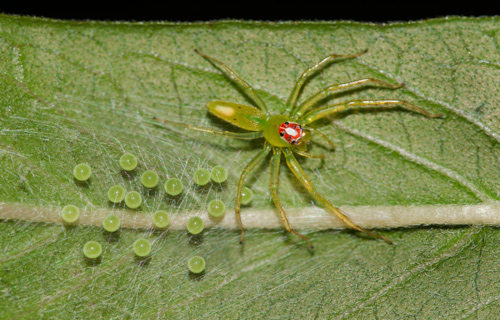
Magnolia Green Jumper Facts
- Next up among our choices for inclusion in this composition about 7 Gorgeous Invertebrates of Georgia is the Magnolia Green Jumper.
- The descriptive term applied to the creature serves as the most frequently used name for this gorgeous arachnid. It also happens to be the only generally accepted common name it has. Though certainly not unknown, that’s somewhat uncommon.
- Scientific professionals, meanwhile, more often refer to this invertebrate by its official moniker. This term, however, typically used by experts, such as researchers, is harder to pronounce. That’s because the spider bears the official name of he Lyssomanes viridis.
- The dazzling creation of Nature and evolution received this name due to the work of the respected French scientist, Charles, Athanase Walckenaer. He made the first formal acknowledgement of it as a separate and distinct species. This he accomplished in 1837.
- For the moment, this remarkable creature appears to be maintaining a population base that’s both sizeable and stable. That trend further seems to hold true throughout the entirety of its native range. The IUCN, therefore, currently has no listing for it.
- This distinctive arachnid should nevertheless be considered to be facing at least some threats to its continued existence. The majority of these, however, are the same as those perils currently facing the majority of the species on earth, if not all of them.
- Due to the nature of its habitat, the brilliant Magnolia Green Jumper faces the degradation or outright loss of much of its previous range. The greatest threat the Arthropod faces, though, most likely consists of the effects of ongoing climate change.
Magnolia Green Jumper Physical Description
The dazzling Magnolia Green Jumper quickly draws the interest of all those fortunate enough to encounter one. You might even say their distinctiveness jumps out at you! It’s worth noting, however, that the spider merits this interest for reasons other that sheer size.
That’s because this gorgeous creation of millions of years of evolution easily ranks as comparatively small for a variety of jumping spider. Like many of its kindred, the remarkable arachnid also displays a moderate degree of the physiological trait of sexual dimorphism.
In its case, this manifests itself in terms of size. Specifically, the females typically attain a slightly greater size than their male counterparts. Females average a body length measuring about 0.28 – 0.31 in (7 – 8 mm). Males, though, only average 0.20 – 0.24 in (5 – 6 mm).
It’s also noted for possessing somewhat longer legs than average, for a jumping spider, relative to body size. This arachnid further evolved highly complex eyes. These, in fact, provide it with some of the most highly developed and acute vision of all known arthropds.
Yet, it’s the coloring of the aptly-named Magnolia Green Jumper that receives most of the attention. Among mature specimens of both genders, this consists of a mainly pale, nearly translucent green. This, obviously, serves as the source of part of its name.
Other colors also appear, though usually in minute quantities. Several small black spots typically appear on the abdomen. Small scales on the fringes of the body also often manifest varying shades. These generally include such colors as orange, yellow, red, or white.
- Kingdom: Animalia
- Phylum: Arthropoda
- Class: Arachnida
- Order: Araneae
- Family: Salticidae
- Genus: Lyssomanes
- Species: L. viridis
Magnolia Green Jumper Distribution, Habitat, and Ecology
Fortuntely for it, the Magnolia Green Jumper seems to inhabit a comparatively broad section of the globe. That holds true due to the fact that it resides in an area that extends across much of the continent of North America. It also appears in Central America.
Within that broader range, however, it makes its home in only selected sections. The great majority of its numbers live in the southeastern section of the United States. Sporadic sightings of the small animal do occur as far south as the country of Guatemala, though.
The impressive species further exhibits decided preferences in its choice of habitat. Most sighted specimens live in regions of warm, humid forests. Part of its common name also derives from its strong preference for magnolia trees, especially the Southern Magnolia.
Yet, this wonder of Nature also makes appearances in other types of trees, including such types as pine, maple, and oak. Some individuals also live on bushes near the ground. Although it seems to prefer moister climates, specimens often appear in dryer climates, too.
Like virtually all of its relatives, the Magnolia Green Jumper evolved as carnivorous in nature. The only known exception to that pattern is the Bagheera kiplingi. This spider hunts as an ambush predator, typically lunging short distances to pounce on its hapless prey.
Mating occurs in Spring, mainly in May. Subsequent to that, females lay between 25 – 70 eggs. These she places on the underside of leaves. She also guards them closely until they hatch. Folowing their hatching, the female generally perishes soon after, usually by August.
Hemlock Looper
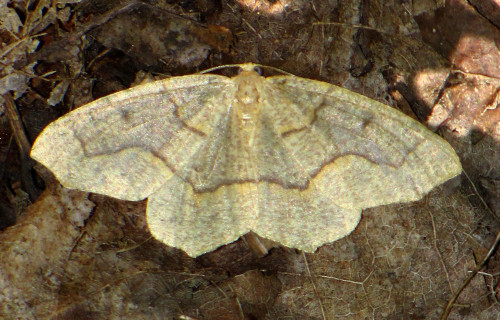
Hemlock Looper Facts
- The next wonder of evolution making an appearance in this listing of 7 Gorgeous Invertebrates of Georgia is the fabulous Hemlock Looper.
- This delicate marvel of Nature, an excellent example of native Lepidoptera, most frequently goes by the common name across its range. The invertebrate also has another, though less used common name. That’s the term of the mournful thorn.
- Professionals, however, typically refer to it by yet another name. That’s the technical name for the small species. Unfortunately, however, like many such terms, its’ rather hard to pronounce. That’s due to the fact that it’s also called the Lambdina fiscellaria.
- The respected French entomologist, Achille Guenée, assigned this tonge-twisting formal name. He made the first known official recognition of the insect as a separate and distinct species. This scientifically noteworthy event further occurred in 1857.
- Regrettably, though, in some parts of its native range, it’s viewed as a serious pest. That holds true due to the feeding habits of its caterpillar form. When present in sufficient numbers, these pose a serious threat to several varieties of trees in local area.
- For the moment, this impressive invertebrate appears to be maintaing a population base that’s both sizeable and stable. This also seems to hold tue throughout the entirety of its natural range. The IUCN, therefore, presently has no listing for it on its Red List.
- The Hemlock Looper nevertheless should be considered as facing several threats to its continued existence. Habitat loss, chiefly due to human activities, naturally constitutes a potential danger. Its greatest threat, however, comes from climate change.
Hemlock Looper Physical Description
The appealing Lepidoptera known by the attention-grabbing common name of the Hemlock Looper garners some attention due to its dietary habits, to be sure. Yet the remarkable insect also merits its own degree of appreciation due to its sheer visual appeal, too.
It further manages to earn a certain degree of appreciation for its natural beauty alone. Its physical size isn’t a factor in that particular aspect. That’s because it remains only an average-sized specimen of its kind, unlike some giants, like the Giant Atlas Moth.
More specifically, mature adults of the species possess an average wingspan of roughly 1.4 in (3.5 cm). Exceptional individuals do occur occasionally, of course. These uncommon specimens, however, rarely exceed this measurement by more than a small fraction.
Unlike many of its relatives, though, the Hemlock Looper displays no noticeable degree of the physiological characteristic of sexual dimorphism. This lack of distinguishing traits between the genders further includes both sheer size and physical appearance.
Adults of both genders therefore present the same general pattern of colors, as well as size. This principally manifests as a cream colored background over most of the body and wings. Thin, dark lines, however, generally also cross both the forewings and hindwings.
- Kingdom: Animalia
- Phylum: Arthropoda
- Class: Insecta
- Order: Lepidoptera
- Family: Geometridae
- Genus: Lambdina
- Species: L. fiscellaria
Hemlock Looper Distribution, Habitat, and Ecology
Fortunately, both for the Hemlock Looper itself, and those of us who appreciate Nature, it evolved as native to a relatively wide section of the globe. That’s due to the fact that the Arthropod evolved as native to much of the continent of North America.
Within that vast area, though, its range extends as far north as the southern portions of the country of Canada. From there, it makes appearances throughout the United States. The range of the small moth does not, however, extend into the country of Mexico.
In both of the countries on the continent that it does appear in, though, the great majority of its numbers tend to live in the eastern half of the continent. In all regions, however, the creature typically makes its home in areas of either coniferous or deciduous forests.
Although the caterpillar froms feed on virtually every variety of tree in their habitat range, they do show certain preferences. As the common name implies, though, these show a strong preference for hemlock trees. Yet they consume most others, as well as some shrubs.
Other than hemlock trees, the favorite food sources of the caterpillar form includes such indigenous tree species as white spruce, oak, and balsam fir. The mature adults, meanwhile, like many of their relatives, feed on the nectar of various local plant species.
The adult Hemlock Looper typically flies between August and early October, in most instances. After mating, the female lays large numbers of eggs, usually either in small groupings, or even singly. These she further places on bark, twigs, foliage, or even debris.
Black Widow
Black Widow Facts
- Now up in this collection of 7 Gorgeous Invertebrates of Georgia comes one of the best known arachnids on earth, the Black Widow.
- Perhaps most notably for most individuals, this amazing invertebrate represents a very dangerous variety of spider. Placed in the Latrodectus genus, many of these reclusive arachnids are also known to some people simply as widow spiders.
- Experts also currently list 32 known species in this genus, spread throughout much of the world. The three species endemic to North America remain the most commonly known, though. Each of these arachnids shares many physical traits.
- The common name for these dangerous invertebrates derives from the high prevalence of sexual cannibalism in the Black Widow. After mating the larger female commonly, though not always, kills and then feeds on the smaller male.
- The toxin of its bite additionally remains considered by most experts to be especially dangerous. The invertebrate earns this distinction due to the presence of the neurotoxin latrotoxin. This represents an especially dangerous type of venom.
- Only the bite of the female typically presents any danger to humans, however. That’s because she generally has far larger venom glands than her much smaller male counterpart. Despite its reputation, though, few bites actually result in fatalities.
- Presently, the majority of species grouped under this common name continue to have stable populations. The IUCN, therefore, does not list them on its Red List. These amazing spiders nevertheless face the same threat from climate change as we all do.
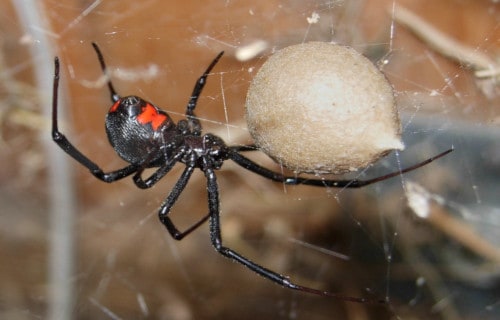
Black Widow Physical Description
Not surprisingly, the various species of Black Widow attain similar physical sizes. However, this remarkable arachnid typically displays a significant amount of sexual dimorphism. This physiological characteristic manifests itself in terms of both color patterns and size.
That’s partly because the female attains an average length of about 1.4 in (3.5 cm), whereas the male stays much smaller. He most commonly only reaches an average length of roughly 0.7 in (1.75 cm). The males also do not display the characteristic red hourglass.
Color patterns also vary relatively significantly between the various forms. All members of this genus, however, appear predominantly black in color. The females of each species, though, all display a very prominent red hourglass shape on their abdomens.
- Kingdom: Animalia
- Phylum: Arthropoda
- Class: Arachnida
- Order: Araneae
- Family: Theridiidae
- Genus: Latrodectus
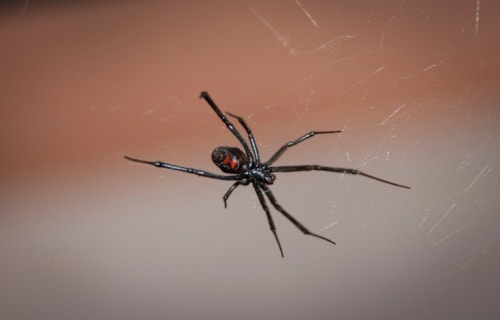
Black Widow Distribution, Habitat, and Ecology
The three species of Black Widow that evolved as native to North America remain the best known of the varieties. The incredible genus also thrives in many other areas of the world, though. In fact, the various species inhabit every continent of the world, except Antarctica.
Quite understandably, given its nearly global distribution, habitat types vary widely. Nevertheless, members of the genus most commonly live in temperate and tropical climates. A few of them, though, even live in extremely arid regions of the world.
Individuals usually build their webs in locations such as around rubble, small trees and bushes, in the wild. But, when found inside of human habitations, webs usually appear in isolated areas, such as attics and garages. This fortunately makes encounters rare.
When a human gets bitten, the venom of a Black Widow commonly causes a condition known as latrodectism. Experiences include profuse sweating, vomiting, muscle rigidity, and extreme pain. These symptoms typically persist for 3-6 days, but can last longer.
All currently known members of this genus hunt as ambush predators, laying in wait in the web. It feeds opportunistically, making a meal of any small creature caught in its web. Its diet, however, typically consists of mosquitoes, grasshoppers, beetles, and such.
Eight-Spotted Forester Moth
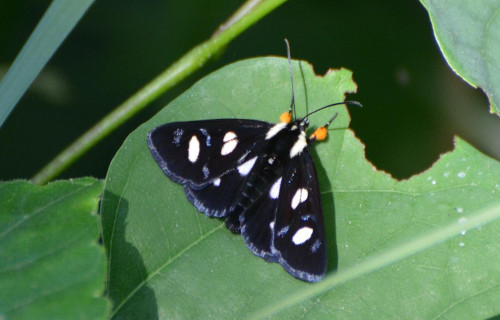
Eight-Spotted Forester Moth Facts
- Our next selection for inclusion in the grouping of 7 Gorgeous Invertebrates of Georgia is named the Eight-Spotted Forester Moth.
- This magnificent Lepidoptera is, understandably, most commonly referred to by the somewhat cumbersome term due to its appearance. For the moment, unlike many of its related species, this marvel has no other generally accepted common name.
- Professional researchers, meanwhile, typically refer to the insect by its official scientific name. That term, however, doesn’t really roll off the tongue much more easily. That’s because it’s scientific name is the equally hard to pronounce Alypia octomaculata.
- The Arthropod received that name at the hands of the renowned Danish researcher Johan Christian Fabricius. The respected zoologist made the first formal recognition of it as a separate and distinct species. That noteworthy even occurred in 1775.
- This beautiful insect holds a better position than many. For the moment, this marvel of Nature appears to be maintaing a population base that’s both sizeable and stable. This further appears to hold true throughout the entirety of its natural range.
- The IUCN, therefore, currently has no listing for the Eight Spotted Forester Moth. Any such status would be reflected on the organization’s Red List of Threatened Species. That fortunate situation, however, could potentially change in the very near future.
- That’s due to the fact that, like most species, if not all, it faces potential threats to its existence. One of those consists of habitat loss, due to human expansion and activities. Its greatest potential threat, though, likely comes from ongoing climate change.
Eight Spotted Forester Moth Physical Description
The fabulous Eight Spotted Forester Moth actually often passes for a butterfly, among the non-professionals who encounter them. Indeed, the amazing invertebrate strongly resembles its cousins in terms of both behavior and general physical appearance.
Although it’s a truly impressive species, it doesn’t earn that accolade based on sheer physical size. That’s because it’s an average-sized member of its genus. It also displays no discernible amount of the physiological characteristic known as sexual dimorphism.
Individuals of both genders therefore appear virtually identical to the naked eye. In terms of size, mature specimens attain an average wingspan of roughly 1 – 1.5 in (2.5 – 3.8 cm). Exceptional individuals do occur, of course, but these remain extremely uncommon.
The overall coloring of adult examples of the Eight Spotted Forester Moth remains principally black. Various parts of the wings do, however, display small variations in this pattern. The body, meanwhile, generally remains almost entirely black in coloring.
The wings of the Arthropod, though, do show some spots of color. Each forewing manifest two light yellow spots. The hindwings also each display two spots, these being white in color. Patches of bright orange hairs also develop on both the front and middle pair of legs.
- Kingdom: Animalia
- Phylum: Arthropoda
- Class: Insecta
- Order: Lepidoptera
- Family: Noctuidae
- Genus: Alypia
- Species: A. octomaculata
Eight Spotted Forester Moth Distribution, Habitat, and Ecology
Regrettably, the stunning Eight Spotted Forester Moth inhabits a moderately restricted swathe of the globe. That range also has a highly broken nature to it. For the moment, no evidence exists to indicate that it ever possessed a more extensive range.
This inspiring creation of Nature and evolution evolved as native to a limited portion of North America. Its population mainly appears in the eastern portion of the United States. Smaller groupings, though, also appear in parts of the countries of Canada and Mexico.
Even within its native range, this Lepidoptera has very specific requirements for its choice of habitat. The vast majority of adults appear in the narrow zone where wooded areas meet open areas. This unique placement serves to meet two of its principal needs.
That’s due to the dietary needs of both its adult and larval forms. The open areas provide the adults with quantities of flowers, from which they feed on the nectar they require. The larva, meanwhile, find the specific plants upon which they feed in the wooded areas.
Adults of the Eight Spotted Forester Moth most commonly appear in the Spring. In warmer regions, two lifecylces occur per year. The dense, forested regions also provide the adults with sufficient foliage for the laying of their eggs, typically under the leaves.
This natural wonder truly stands out from most of its relatives due to its behavioral patterns. That’s due to the fact that, unlike most moths, it flies during the daytime. Its feeding activities further serve as a source of pollination for the many various flowers in its area.
Grizzled Mantis
Grizzled Mantis Facts
- Now appearing in this compendium of 7 Gorgeous Invertebrates of Georgia we present to you the aptly-named Grizzled Mantis.
- The highly descriptive term for the insect serves as generally used common name for a most unusual variety of mantid. But that’s not its only name. Professional researchers likely know it better by the scientific name of the Gonatista grisea.
- Regardless of the name used for this mantis, it remains a most remarkable species. This holds true due to the extreme camouflage abilities it displays. While most mantises utilize this principle, very few take it to the level of this creature.
- The first known identification of this marvel of Nature actually occurred more than two centuries ago. More precisely, that took place in the year 1793. That arose from the incredible work of the Danish zoologist Johan Christian Fabricius.
- For the moment, the IUCN has no listing for this species. Any such listing would appear on the organization’s Red List of Threatened Species. This occurs because of a combination of its natural range and apparently stable population base.
- The Grizzled Mantis, like many related species, nonetheless may be considered to be at risk. Just as them, this insect must deal with ever-declining choices of habitat. It must, however, also be considered to be at further risk from the effects of climate change.
Grizzled Mantis Physical Description
While the beautiful Grizzled Mantis does impress the viewer, it does not do so due to physical size. In point of act, this amazing invertebrate represents slightly smaller than average-sized variety of mantid. Like its many brethren, it also displays sexual dimorphism.
In its case, though, the difference remains quite small. As it happens, females attain an average body length roughly 0.08 in (2 mm) greater than the males. Males reach an average length equaling 1.5 in (38 mm). Meanwhile, the females average 1.58 in (40 mm) long.
The males also tend to have a somewhat slimmer form than their female counterparts. Otherwise, both genders appear identical. The overall color scheme consists of a grayish-green, with mottled dark markings. These usually appear as a mix of brown and black.
It head further displays the triangular shape typical of mantises. However, the eyes of the Grizzled Mantis grow particularly large. Those of the males generally grow slightly larger. The antennae of this species are commonly about half the length of the body.
- Kingdom: Animalia
- Phylum: Arthropoda
- Class: Insecta
- Order: Mantodea
- Family: Mantidae
- Genus: Gonatista
- Species: G. grisea
Grizzled Mantis Distribution, Habitat, and Ecology
The fabulous Grizzled Mantis has a moderately extensive range of habitation. However, that’s also quite broken in nature. The majority of individuals appear in an area from the states of Florida to South Carolina, in the United States, in North America.
But, scattered smaller populations also appear kin other locations. These include portions of Cuba, Jamaica, and Puerto Rico. Yet, it remains unknown if these represent true native populations. The possibility exists that these could have been unknowingly transplanted.
Wherever it appears, the arthropod has decided habitat preferences. This species prefers any area with plentiful foliage, most especially various trees. Obviously, this mainly includes local forests, but can include parks, and even private yards.
Like other mantids, the fascinating Grizzled Mantis evolved as a fully predatory carnivore. In its case, it prefers to hunt on trees, where it can make maximum use of its camouflage abilities. Its prey consists almost exclusively of varying small arthropods.
After mating, eggs are enclosed in a protective case. Most commonly, the female attaches this to a leaf or twig. As many as 200 eggs may be found in a single case, known as an ootheca. Once hatched, these quickly progress to adulthood, usually with a 1-year life span.
Luna Moth
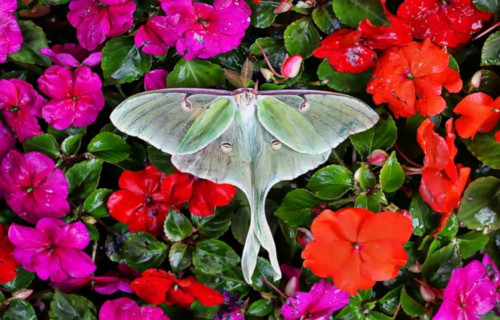
Luna Moth Facts
- The final entry into this article about 7 Gorgeous Invertebrates of Georgia is the otherwordly marvel of Nature named the Luna Moth.
- This stunning variety of Lepidoptera bears the common name in all its range. It also holds the comparatively short and simple scientific name, however, of the Actias luna. By either term, though, it represents a fabulous and fascinating creature.
- Like many of its kindred, it owes its scientific name to one of the best known of early researchers. In this case, that’s the renowned Swedish botanist and zoologist, Carl Linnaeus. He made the first official recognition of it as a separate species in 1758.
- That wasn’t its first discovery, however. In point of fact, it holds a place of moderate historical importance in the annals of science. That’s because of its earliest recognition. While Carl Linnaeus gave it its first formal recognition, it was first noted in 1700.
- That fact made it the first insect of its kind to be described in any way in scientific literature. It also holds yet another distinction, though. The invertebrate, in point of fact, easily ranks as one of the largest moths found anywhere in its native range.
- This magnificent Lepidoptera also holds yet another status in the local popular culture of a specific portion of its range. This occurs due to the fact that the arthropod appeared on a first-class postage stamp in the United States, issued in June 1987.
- For the moment, the Luna Moth appears to be maintaining a stable and sufficient population base. The IUCN, therefore, presently lists it as Least Concern. It nonetheless does face some threats. These include habitat loss and climate change.
Luna Moth Physical Description
Though not its only distinctive feature, the magnificent Luna Moth nonetheless does impress one due to its sheer size. In point of fact, it ranks as one of the largest of all Lepidoptera, in terms of wingspan. That size varies greatly among individuals, however.
The invertebrate further displays a slight degree the the physiological trait of sexual dimorphism. In its specific case, though, this has nothing to do with physical size. Instead, this manifests itself in the fact that the antennae of the male grow longer and wider.
Otherwise, the genders remain remarkably similar in appearance. Both sexes attain an average wingspan measuring roughly 4.5 in (11.4 cm). Some exceptional individuals, however, reach a span of as much as 7 in (17.8 cm). These giants truly distinguish themselves.
Regardless of their span, though, the wings of the breathtaking Luna Moth deserve appreciation for their mere appearance. That’s because of their striking and unique coloring. This consists of a bright lime-green background, offsetting the mainly white body.
The wings also display yet another distinctive characteristic. More precisely, the hindwings stand out. These features develop as highly elongated in shape. This remarkable evolutionary trait only serves to separate and distinguish the species from its brethren even more.
- Kingdom: Animalia
- Phylum: Euarthropoda
- Class: Insecta
- Order: Lepidoptera
- Family: Saturniidae
- Genus: Actias
- Species: A. luna
Luna Moth Distribution, Habitat, and Ecology
The visually unique and stunning Luna Moth, quite fortunately, has an advantage over many related creatures. That’s due to the fact that it inhabits a comparatively extensive range of the world. Yet at the same time, that habitat range qualifies as very specific.
In point of fact, it makes it evolved as native a very specific portion of the continent of North America. More precisely, it inhabits a large portion of the eastern half of the United States. This extends from Florida to Maine and a small portion of extreme northeast Canada.
Within this range, though, the magnificent Lepidoptera exhibits a relatively great degree of flexibility and adaptability in terms of habitat. As a result of this versatility, it inhabits various types of habitats, providing a sufficient number of certain types of plants are present.
Like most of its kind, the Luna Moth evolved as nocturnal in nature. Flying at night, females release powerful pheromones, to attract the males. These the males detect with their sensitive antennae. They can further do so from as great a distance as several miles.
Although adults do not feed for the duration of the life cycle, the larvae feed voraciously, typically on the same tree their cocoon was place on. It also feeds primarily on several varieties of broadleaf trees and is itself mainly preyed upon by bats and various birds.

7 Gorgeous Invertebrates of Georgia
We hope that each of you completely enjoyed reading, and hopefully learning from, this article we’ve presented about 7 Gorgeous Invertebrates of Georgia. It’s also our hope that doing so has left you with either a new or renewed appreciation for such wonders of Nature.
Unfortunately, however, many of their kindred around the world now find themselves facing strong threats to their continued existence as a species. Many of those dangers, in fact, stem from the actions of mankind. We must do all we can to protect and preserve them all.
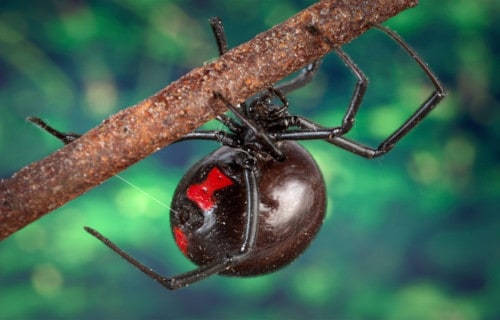
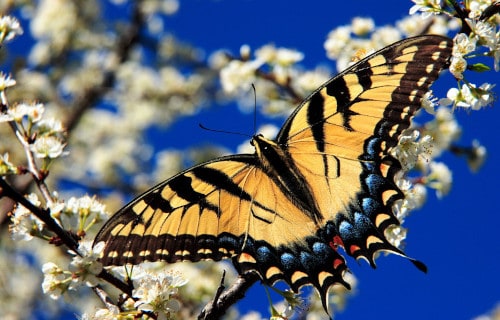
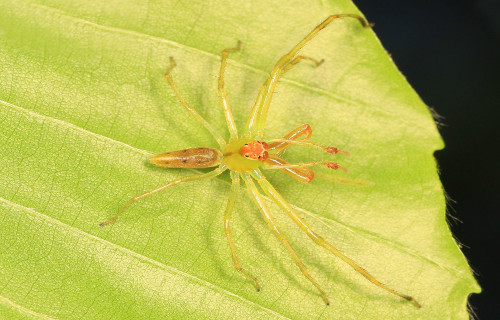
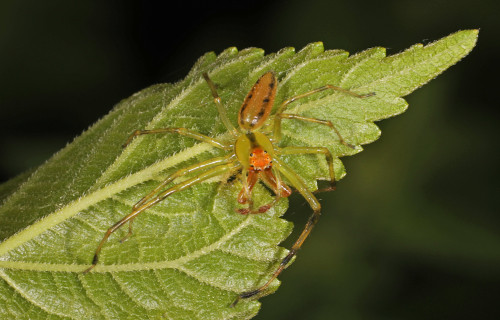
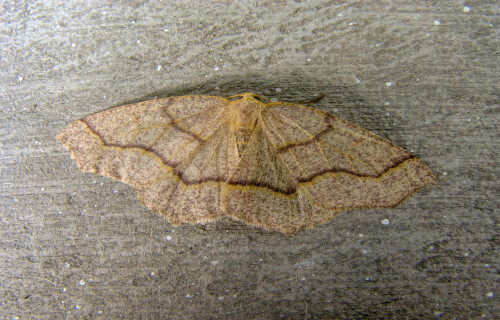
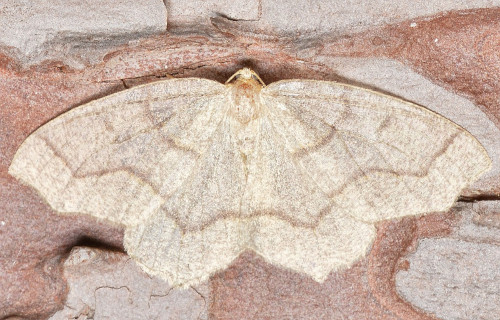
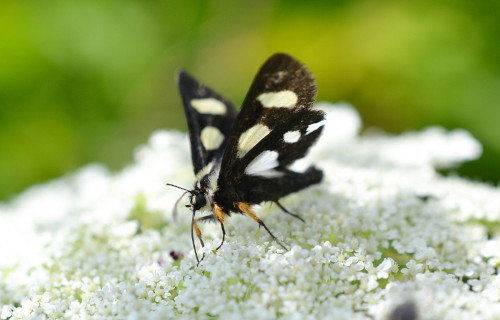
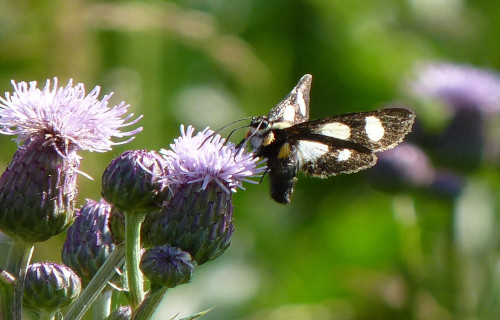
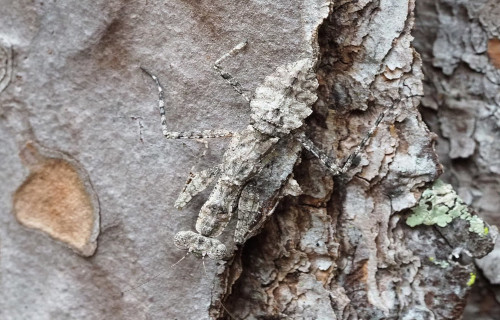
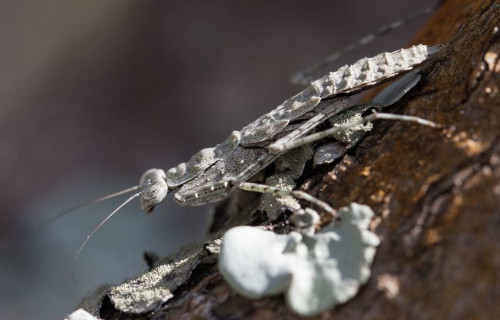
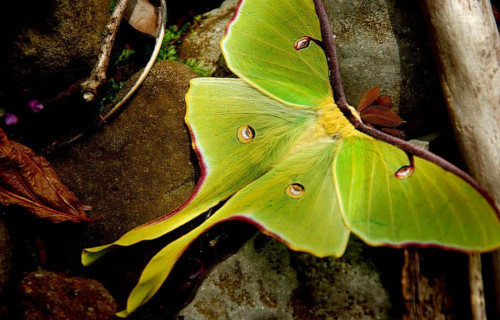
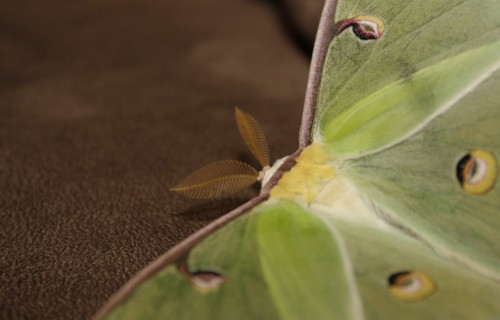









This is wonderful i love it so much
Hello Carmelo,
Thank you very much. We are pleased you found it so. We strive to do our best for our readers.
Sincerely,
OBP
very good
Hello Carmelo,
Thank you. We appreciate your interest and patronage.
Sincerely,
OBP